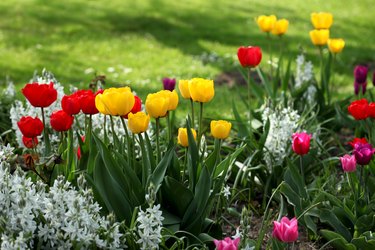
Tulips are among the top choices in spring bulb plants. Planted in fall, tulip bulbs produce bright, beautiful blossoms in a dramatic range of colors. But what happens to the bulb after the plant wilts? It is possible to hope for more years of spring flowers if you are willing to do the work.
Meet the Tulip
Video of the Day
It's not the only plant called the harbinger of spring, but the tulip (Tulipa spp.) has as much right to the title as any other. Tulips are perennial bulb plants that produce cup-shaped flowers in a vast range of solid and mixed colors. The species plant is now joined by an army of hybrid cultivars with a variety of amazing color patterns, ruffles, and fringes.
Video of the Day
Like all spring bulb plants, tulips are planted in the fall. Each bulb contains all that is necessary to produce a flower. The bulb develops its root system over the winter months and then bursts into bloom when the temperatures warm up in spring.
Understand Perennial Tulips
An annual plant is one that completes its life cycle in one growing season. It grows, produces seeds, and dies the same year, and the gardener tosses it out. Contrast this with perennials, plants that live for more than one year and sometimes for many years if their cultural needs are met. The perennial's foliage dies back in winter, but it regrows the following spring.
The species tulip is a perennial plant, producing large, lovely flowers in subsequent years. But it is sometimes grown as an annual: planted in fall, allowed to bloom, and then dug up and thrown away. Sometimes, the gardener doesn't want to go to the trouble of giving the tulip the care it needs to recharge its energy, but it can also be the climate or the type of bulb.
Grow a Perennial Tulip
If you want to regrow a flower from a tulip bulb after the first-year blossom dies back, you'll need to make sure the bulb gets what it needs. First, select a common tulip bulb, also known as the species plant, rather than one of the fancy hybrids. Hybrids are usually grown as annuals, while species tulips grow for many years and can even naturalize.
Second, be sure to plant the tulip bulbs correctly in a full-sun location with well-drained soil. Work in organic compost and bulb fertilizer when planting. Use a bulb planter to prepare the hole and then place the bulb some 6 to 8 inches deep. Add an extra spoonful of nitrogen fertilizer in spring when shoots first appear. Clip off spent flower stems after the tulip is finished blooming but leave the foliage in place until it turns yellow.
Note that tulips do best in regions where the winters are cool and moist and the summers are warm and dry. In an area with short springs, it may be difficult for the bulb to get enough sun to produce sufficient energy for the next year, and very warm regions will not allow the period of cool dormancy that tulips require to rebloom.